For couples and individuals struggling with infertility, assisted reproductive technology (ART) like in vitro fertilization (IVF) can allow intended parents to bring a baby into the world. The International Committee for Monitoring Assisted Reproductive Technologies estimates that at least 12 million babies have been born as a result of IVF embryo transfers and other ARTs.
For intended parents undergoing IVF, the last procedure before your blood pregnancy test will be an embryo transfer. But what does an embryo transfer mean for you, and what are your options when it’s time for this long-awaited day?
What Is an Embryo Transfer?
Simply put, an embryo transfer involves taking the fertilized egg and sperm and implanting the newly-formed embryo into an intended mother or surrogate's uterus. The embryos’ placement within the uterus must be precise, so your fertility doctor will guide this transfer by a pelvic ultrasound.
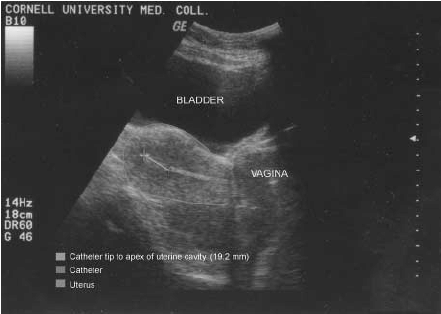 Source: ResearchGate
Source: ResearchGate
Because the ultrasound gives your reproductive doctor visibility into the perfect placement for the catheter, they can reduce the possibility of the catheter touching your cervix. If this does occur, fear not, you will only experience a mild cramping sensation.
As a part of the in vitro fertilization cycle, embryo transfers can significantly improve intended parents’ chances of conceiving. Often, intended parents experiencing male factor infertility, female factor infertility, or both turn to IVF to achieve a successful pregnancy and birth.
Why Intended Parents Turn to Embryo Transfers
While the specific cause(s) of infertility may be unknown, your fertility clinic and reproductive endocrinologist will work with you to identify your source of infertility and how to best achieve a successful pregnancy.
Embryo transfers are an excellent option for intended parents who have:
- Fallopian tube damage or blockage. If your fallopian tubes are damaged or blocked, the egg will struggle to become fertilized and travel to the uterus.
- Ovulation disorders. Irregular or absent menstrual cycles mean fewer eggs are available for fertilization, increasing the difficulty of getting pregnant naturally.
- Endometriosis. Occurring when uterine tissue implants and grows outside of a woman’s uterus, this affects the function of ovaries, uterus, and fallopian tubes.
- Uterine fibroids. These are benign tumors on the uterus wall that can interfere with the embryo implantation needed for a successful conception.
- Tubal ligation. If you’ve had your fallopian tubes cut or removed permanently, IVF and an embryo transfer can allow you to conceive successfully.
- Poor sperm motility or morphology. Male factor infertility is common, causing infertility in couples ⅓ of the time. Undergoing ICSI to fertilize the egg can achieve a successful embryo for implantation.
Types of Embryo Transfers
To retrieve and fertilize the intended mother’s eggs with sperm during IVF, you’ll have the option of picking between a few different options.
- Frozen Embryo Transfers (FETs)
- Fresh Embryo Transfers (ETs)
- Day 3 Embryo Transfer
- Day 5 Embryo Transfer
- Multiple vs. Single Embryo Transfer
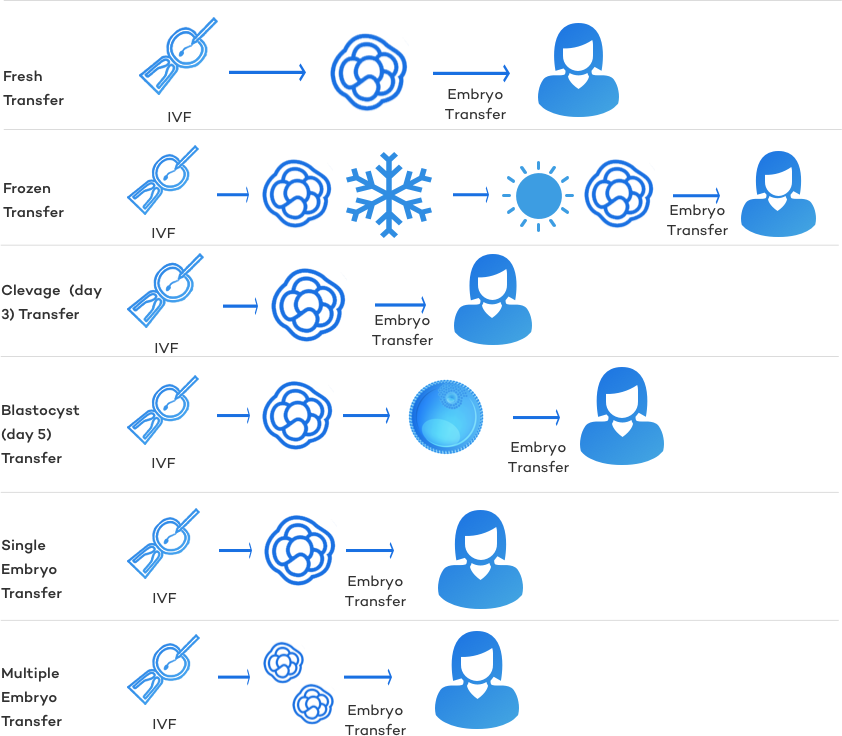 Source: CYN Fertility
Source: CYN Fertility
Frozen Embryo Transfers (FETs)
Embryos from past IVF cycles can be stored and frozen for an indefinite period. Because of this, many intended parents with leftover embryos from previous egg retrievals opt to thaw and then transfer their excess embryos when this happens.
Frozen embryo transfers are the most commonly performed kind of transfer, because they allow for genetic testing of embryos before implantation, which creates higher success rates and less chance of genetic defect or miscarriage.
Your doctor uses a fine transfer catheter during a frozen embryo transfer to place the thawed embryos past the cervix into your uterus. A frozen embryo transfer is a simple procedure and often doesn’t require pain relief, though medicated and partially medicated treatments are offered for your comfort.
Fresh Embryo Transfers (ETs)
Once the intended mother’s eggs have been retrieved and fertilized, your fertility doctor will determine which embryos have the best chance of implantation. Three to five days after the initial retrieval, your fertility doctor will transfer the newly created embryos back into the intended mother or surrogate's uterus.
Day 3 Embryo Transfer
Also known as a Cleavage embryo, these embryos are named after the cells in the embryo, which are cleaving or dividing. However, the embryo itself is not growing in size. Because not all embryos can survive until Day 5, some fertility doctors transfer embryos back on Day 3 to ensure that the embryo can thrive within a woman’s uterus.
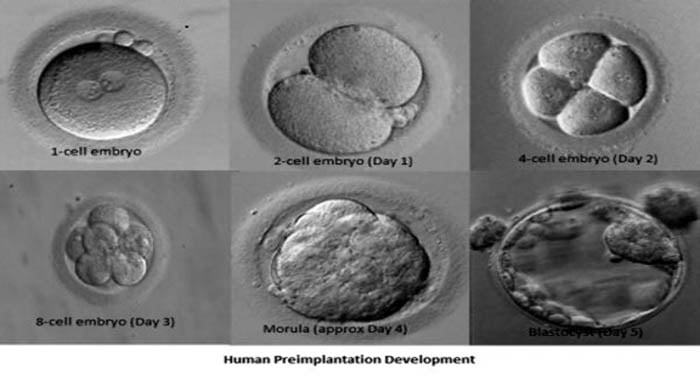
Day 5 Embryo Transfer
Also called a Blastocyst, the day five embryo has developed into a sphere of 60 to 120 cells surrounding a fluid-filled cavity. Blastocysts typically form on day five but can happen beyond then.
Blastocysts are often considered a better option than an earlier stage embryo because they have a higher chance of being genetically normal, implanting and leading to a successful pregnancy compared to Day 3 embryo transfers. By prolonging the time before you transfer the embryo, your fertility doctor can better elect the embryo(s) with the best chance of implantation and successful pregnancy.
Multiple vs. Single Embryo Transfer
Intended parents often wonder if transferring multiple embryos increases the likelihood of a successful pregnancy following your IVF cycle. The truth is, there’s no one answer to this question, as fertility clinics all have different policies regarding how many embryos are transferred into the woman’s uterus.
In many cases, your fertility specialist will only transfer one embryo into the uterus. Sometimes, transferring two embryos can increase the chances of successful implantation for women 35 or older. Factors that determine how many embryos to transfer include the embryo recipient’s age and her reproductive history.
According to a PubMed Central study, IVF procedures using a single embryo transfer had a live-birth rate nearly 10% higher than that of multiple embryo transfers. Transferring multiple embryos can result in more live births, but it does increase the chances of medical complications for both the intended mother and the baby/babies. Multiple embryo transfers are done less and less frequently as medical technology and techniques improve.
Rather than increasing the number of embryos transferred during IVF, intended parents saw the biggest positive impact on success rates when performing preimplantation genetic testing and diagnosis (PGS/PGT-A/PGD). These tests allow your fertility doctor to analyze and evaluate which embryo(s) have the highest chance of implantation and a healthy conception, boosting your likelihood of a successful cycle.
Talk to your specific fertility doctor about whether you’d be a good candidate to transfer multiple embryos and if PGS/PGT-A/PGD is right for you.
Benefits and Risks of Embryo Transfers
When deciding to use fresh or frozen embryos, there’s a wide range of considerations. Both have benefits, and both have downsides.
Note that cramping and vaginal bleeding are common, but more severe side effects like perforation of the uterus and infection are incredibly rare. Make sure that you select a fertility clinic with no track record of these risks associated with IVF or embryo transfers.
Pros and Cons of Fresh Embryo Transfers
With both frozen and fresh embryo transfers, women will have their endometrium (uterine lining) evaluated for thickness and quality. However, fresh embryo transfers use ovarian stimulation medication during the IVF cycle to cause an increase in estrogen levels, whereas frozen embryo transfers use different types of medications (or no medications) to help the uterine lining.
The main benefit of using a fresh embryo transfer is the shorter time to conception. There’s a maximum of five days spent waiting after the egg retrieval and embryo transfer into the uterus. Additionally, insurance companies are less likely to cover the cost of embryo cryopreservation or embryo freezing, so patients opt for fresh transfers for financial reasons.
However, there are constraints for individuals considering fresh transfers. If a woman’s progesterone level is elevated, a fresh embryo transfer would likely be unsuccessful due to conditions surrounding embryo implantation. Additionally, patients at risk for ovarian hyperstimulation syndrome (OHSS) should avoid using fresh transfers, as the medications used to induce egg maturation can be harmful.
Pros and Cons of Frozen Embryo Transfers
Women opt for frozen embryo transfers for many reasons. Let’s explore some key benefits and drawbacks surrounding frozen embryo transfers (FET). Perhaps you want to give your body downtime after an egg retrieval procedure, or maybe your focus was originally fertility preservation, but you finally feel ready to get pregnant with the egg or embryo of a previous cycle.
Perhaps the most important benefit of frozen embryo transfers, is that unlike fresh transfers, frozen transfers allow for embryos to be genetically tested before implantation, increasing success rates, and lowering the odds of genetic abnormalities.
Frozen embryo transfers are common, and many IVF clinics encourage patients to go “frozen.” If a patient has leftover embryos from a fresh cycle, the patient doesn’t need to undergo an additional egg retrieval to create embryos. Frozen embryos remain viable well over ten years after their initial freeze, so intended parents can choose to do a FET cycle following an unsuccessful IVF cycle at any point in the future.
Frozen transfers also allow time for a woman’s hormones and biology to recover from the influence of the fertility medications that were used for the retrieval. Frozen transfers are also good for women experiencing ovarian hyperstimulation syndrome (OHSS), elevated progesterone levels during ovarian stimulation, which can indicate that the embryo and uterus are out of sync.
How To Prepare for Your Embryo Transfer
If you’re preparing for your first embryo transfer, don’t worry -- you’ll be in the most competent, experienced hands. The embryo transfer will occur three to five days after fresh egg retrievals or longer if you’re using frozen embryos.
As you prepare for your embryo transfer, make sure you:
- Organize and take your medications routinely. Ask your doctor if you should take over-the-counter medications and supplements, like Vitamin D. Make sure you’re also taking your fertility medications and hormones.
- Stock up on self-care and entertainment (but avoid chemicals!).
- Consider holistic therapies. Acupuncture, yoga, and massages may improve pregnancy rates by up to in women undergoing IVF treatments.
- Get plenty of rest before and after. Give your body downtime, and avoid strenuous activity.
- Avoid extreme temperatures against your abdomen and uterus. This can deregulate your reproductive system and impact your embryo transfer’s success.
- Eat a high-fat, low-carb diet. This will reduce inflammation throughout your body, G.I. tract, and reproductive system.
- Avoid chemical products. This can include nail polish, some shampoos, cleaning supplies, and more.
- Plan ahead. The day before your transfer procedure, pack a bag, pick what time to leave, etc...
- Come with a full bladder. Drink plenty of water for the ultrasound-guided transfer!
For more specific information about how to best prepare for your embryo transfer, talk to your reproductive endocrinologist.
While doing the above cannot ensure you a successful conception and pregnancy, have faith and trust in your fertility doctors. You’re in talented hands, and it’s important to have trust in the process!
The Embryo Transfer Procedure
The embryo transfer itself is very similar to a pap smear, and is a short procedure, often lasting between 15 and 30 minutes. Your reproductive doctor will insert a speculum into the woman’s vagina with ultrasound for accuracy during this procedure. Then, your doctor will pass a catheter through the cervix and into the womb. From there, the embryos are passed through the tube and into the womb.
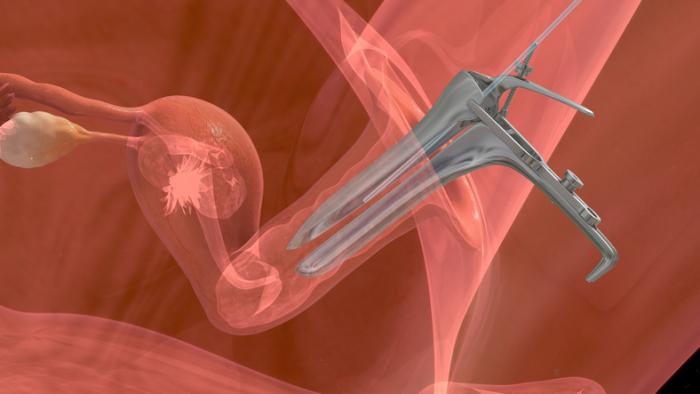 Source: Medical News Today
Source: Medical News Today
Once the transfer is complete, you will be given around an hour to lie down on your back and relax. However, you may not need all of this time as it is not a largely invasive procedure. In total, the entire procedure and included rest time only takes place over 2 to 4 hours.
What To Expect After Your Embryo Transfer
Your fertility clinic will always offer you detailed instructions after appointments to make you feel comfortable and confident that you are taking care of yourself during the days leading up to the post-embryo transfer pregnancy test and know what to expect after your embryo transfer.
Some doctors recommend 24-hour bed rest post-procedure, while other sources recommend relying on low-impact movement to cause blood flow to the uterus with the hopes of increasing the chance of pregnancy.
However, it’s crucial to avoid strenuous exercise, sex, or taking baths. Maintain a positive outlook on your embryo transfer procedure, and behave as if you’re pregnant -- food and all!
Wait Two Weeks Before Taking Your Post-Transfer Pregnancy Test
Although it’s tempting to take a pregnancy test a few days after your embryo transfer, try to abstain -- fertility clinics strongly recommend you wait the typical two-week period to ensure that you receive accurate results and manage the emotions are expected during this process.
Clinics recommend a two-week wait because taking a pregnancy test too soon after the embryo transfer often produces false results. This happens because the hormone used to measure pregnancy within a pregnancy test, referred to as hCG, can vary in levels depending on your current phase within your fertility journey. For instance, very early pregnancy often doesn’t result in much natural hCG production, causing you to get a distressing false-negative result.
Once your two weeks have passed, you can take your first pregnancy test after the embryo transfer. To get a more accurate reading, your fertility clinic will book an appointment two weeks after the transfer to perform a blood test to determine the pregnancy result.
Fresh vs. Frozen Embryo Transfer Success Rates
Rest assured that frozen embryos are just as effective as fresh ones, with embryo transfer studies actually pointing toward improved success rates for frozen compared to fresh transfers, primarily due to preimplantation genetic screening and fewer residual retrieval hormones in the recipient’s body. Factors that influence embryo transfer success rates include the recipient’s embryo quality, uterine receptivity, and physician technique and knowledge.
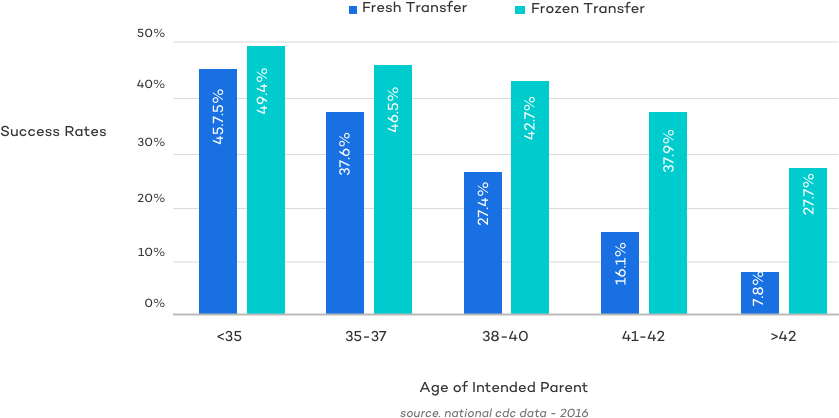
Source: CYN Fertility
Both FET and fresh embryo transfers have multiple factors to consider regarding their respective success rates, including the age of the egg donor or intended mother, egg quality, sperm qualification, and uterine receptivity during the transfer.
However, one of the most significant studies to answer this question used the SART database to analyze patients’ egg retrievals and pregnancy rates following the transfer. If a woman retrieved six or more eggs, she would have a better chance of pregnancy and live birth with a frozen cycle. However, if a woman had less than five eggs retrieved, she’d be more likely to have a pregnancy and live birth with fresh embryo transfers.
How Much Does an Embryo Transfer Cost?
We’re often asked how expensive an embryo transfer procedure is, and it just depends! The cost of a fresh embryo transfer is typically included within your IVF package, and this varies from fertility clinic to fertility clinic.
A frozen embryo transfer typically costs around $3,000 to $6,000 and can sometimes be a separate expense from your IVF package. Even if you do a fresh transfer, most patients will freeze their unused embryos for the potential to be used at a later date.
Embryo Transfers Are Just One Part of Your Family’s Journey
It’s entirely normal for fertility journeys to have many ups and downs, and a failed pregnancy test doesn’t mean that your journey has to come to an end. Your medical specialist will be able to give you an honest assessment of further fertility treatments that you are a candidate for. You can then work together to determine your next steps if you wish to pursue other fertility options or an additional IVF cycle.
If you’re considering parenthood, researching your fertility options, or only looking into IVF treatment services, every patient’s path toward pregnancy will look different. Individuals or couples considering ART procedures can achieve their dreams of bringing a happy, healthy baby into the world.
About Pacific Fertility Center Los Angeles
Parenthood is a universal blessing, and everyone deserves the opportunity to bring a new family member into this world. Pacific Fertility Center of Los Angeles has been bringing babies into the world since 1991, supporting patients in over 75 countries and setting standards of transparency and accountability across the ART community for 30 years.
The fertility specialists at Pacific Fertility Center of Los Angeles would be happy to answer any further questions you may have regarding your embryo transfer process. Contact us to get started today.
Note: This is not intended to be a substitute for professional medical advice, diagnosis or treatment. Information provided is for general educational purposes only and is subject to change without notice. Speak to your doctor directly with any questions you may have regarding a medical condition. Any information contained herein does not replace any care plan as determined by a physician.
You May Also Like
These Stories on In-Vitro Fertilization

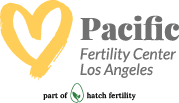
.png)
